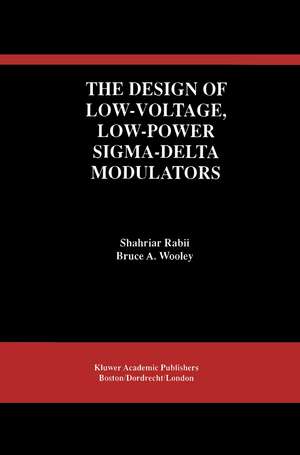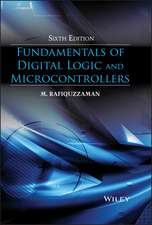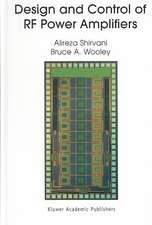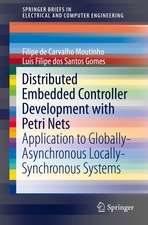The Design of Low-Voltage, Low-Power Sigma-Delta Modulators: The Springer International Series in Engineering and Computer Science, cartea 483
Autor Shahriar Rabii, Bruce A. Wooleyen Limba Engleză Paperback – 12 oct 2012
Although significant power savings can typically be achieved in digital circuits by reducing the power supply voltage, the power dissipation in analog circuits actually tends to increase with decreasing supply voltages. Oversampling architectures are a potentially power-efficient means of implementing high-resolution A/D converters because they reduce the number and complexity of the analog circuits in comparison with Nyquist-rate converters. In fact, it is shown that the power dissipation of a sigma-delta modulator can approach that of a single integrator with the resolution and bandwidth required for a given application. In this research the influence of various parameters on the power dissipation of the modulator has been evaluated and strategies for the design of a power-efficient implementation have been identified.
The Design of Low-Voltage, Low-Power Sigma-Delta Modulators begins with an overview of A/D conversion, emphasizing sigma-delta modulators. It includes a detailed analysis of noise in sigma-delta modulators, analyzes power dissipation in integrator circuits, and addresses practical issues in the circuit design and testing of a high-resolution modulator.
The Design of Low-Voltage, Low-Power Sigma-Delta Modulators will be of interest to practicing engineers and researchers in the areas of mixed-signal and analog integrated circuit design.
| Toate formatele și edițiile | Preț | Express |
|---|---|---|
| Paperback (1) | 940.39 lei 6-8 săpt. | |
| Springer Us – 12 oct 2012 | 940.39 lei 6-8 săpt. | |
| Hardback (1) | 946.55 lei 6-8 săpt. | |
| Springer Us – 31 oct 1998 | 946.55 lei 6-8 săpt. |
Din seria The Springer International Series in Engineering and Computer Science
- 24%
 Preț: 1041.97 lei
Preț: 1041.97 lei - 20%
 Preț: 643.50 lei
Preț: 643.50 lei - 18%
 Preț: 1225.62 lei
Preț: 1225.62 lei - 18%
 Preț: 965.02 lei
Preț: 965.02 lei - 20%
 Preț: 646.12 lei
Preț: 646.12 lei - 18%
 Preț: 948.79 lei
Preț: 948.79 lei - 20%
 Preț: 646.62 lei
Preț: 646.62 lei - 15%
 Preț: 637.46 lei
Preț: 637.46 lei - 20%
 Preț: 643.83 lei
Preț: 643.83 lei - 18%
 Preț: 949.23 lei
Preț: 949.23 lei - 20%
 Preț: 644.48 lei
Preț: 644.48 lei - 20%
 Preț: 994.92 lei
Preț: 994.92 lei - 20%
 Preț: 645.97 lei
Preț: 645.97 lei - 18%
 Preț: 946.87 lei
Preț: 946.87 lei - 20%
 Preț: 995.57 lei
Preț: 995.57 lei - 18%
 Preț: 956.99 lei
Preț: 956.99 lei - 20%
 Preț: 644.98 lei
Preț: 644.98 lei - 15%
 Preț: 649.54 lei
Preț: 649.54 lei - 18%
 Preț: 950.21 lei
Preț: 950.21 lei - 18%
 Preț: 1221.38 lei
Preț: 1221.38 lei - 18%
 Preț: 957.62 lei
Preț: 957.62 lei - 15%
 Preț: 643.99 lei
Preț: 643.99 lei - 18%
 Preț: 948.47 lei
Preț: 948.47 lei - 18%
 Preț: 947.35 lei
Preț: 947.35 lei - 20%
 Preț: 1284.65 lei
Preț: 1284.65 lei - 20%
 Preț: 1633.95 lei
Preț: 1633.95 lei - 20%
 Preț: 1285.78 lei
Preț: 1285.78 lei
Preț: 940.39 lei
Preț vechi: 1146.82 lei
-18% Nou
Puncte Express: 1411
Preț estimativ în valută:
179.97€ • 185.92$ • 149.78£
179.97€ • 185.92$ • 149.78£
Carte tipărită la comandă
Livrare economică 25 martie-08 aprilie
Preluare comenzi: 021 569.72.76
Specificații
ISBN-13: 9781461373223
ISBN-10: 1461373220
Pagini: 208
Ilustrații: XVIII, 187 p.
Dimensiuni: 155 x 235 x 11 mm
Greutate: 0.3 kg
Ediția:Softcover reprint of the original 1st ed. 1999
Editura: Springer Us
Colecția Springer
Seria The Springer International Series in Engineering and Computer Science
Locul publicării:New York, NY, United States
ISBN-10: 1461373220
Pagini: 208
Ilustrații: XVIII, 187 p.
Dimensiuni: 155 x 235 x 11 mm
Greutate: 0.3 kg
Ediția:Softcover reprint of the original 1st ed. 1999
Editura: Springer Us
Colecția Springer
Seria The Springer International Series in Engineering and Computer Science
Locul publicării:New York, NY, United States
Public țintă
ResearchCuprins
1 Introduction.- 1.1 Organization.- 1.2 Simulation Details.- 2 Trends Toward Low-Voltage Power Supplies.- 2.1 Technology Scaling in CMOS Processes.- 2.2 Scaling Theory.- 2.3 Battery Cell Technologies for Portable Electronic Systems.- 2.4 Summary.- 3 Analog-to-Digital Conversion.- 3.1 Analog-to-Digital Converters.- 3.2 Nyquist-Rate A/D Converters.- 3.3 Oversampling A/D Converters.- 3.4 Summary.- 4 Power Dissipation in Sigma-Delta A/D Converters.- 4.1 Power Dissipation in a Sigma-Delta Modulator.- 4.2 Ideal Integrator Power Dissipation.- 4.3 Impact of Circuit Nonidealities.- 4.4 Comparison of Amplifier Topologies.- 4.5 Power Dissipation in the Decimation Filter.- 4.6 Summary.- 5 Design of a Low-Voltage, High-Resolution Sigma-Delta Modulator.- 5.1 Modulator Architecture.- 5.2 Signal Scaling.- 5.3 Integrator Implementation.- 5.4 Circuit Noise.- 5.5 Modulator Specifications.- 5.6 Summary.- 6 Implementation of an Experimental Low-Voltage Modulator.- 6.1 The Integrators.- 6.2 The Operational Amplifiers.- 6.3 The Quantizers.- 6.4 The Clocks.- 6.5 Clock Boosters.- 6.6 Decimation Filtering.- 6.7 Experimental Results.- 6.8 Comparison of the Power Efficiency of A/D Converters.- 6.9 Summary.- 7 Conclusion.- 7.1 Recommendations for Further Investigation.- A Fundamental Limits.- A.1 Power in a Switched-Capacitor Integrator.- A.2 Power in a Continuous-Time Integrator.- A.3 Power in a Switched-Current Integrator.- B Power Dissipation vs. Supply Voltage and Oversampling Ratio.- B.1 Folded Cascode Amplifier.- B.2 Two-Stage Class A Amplifier.- B.3 Two-Stage Class A/AB Amplifier.- C Effects of Capacitor Mismatch.- D Test Setup.















